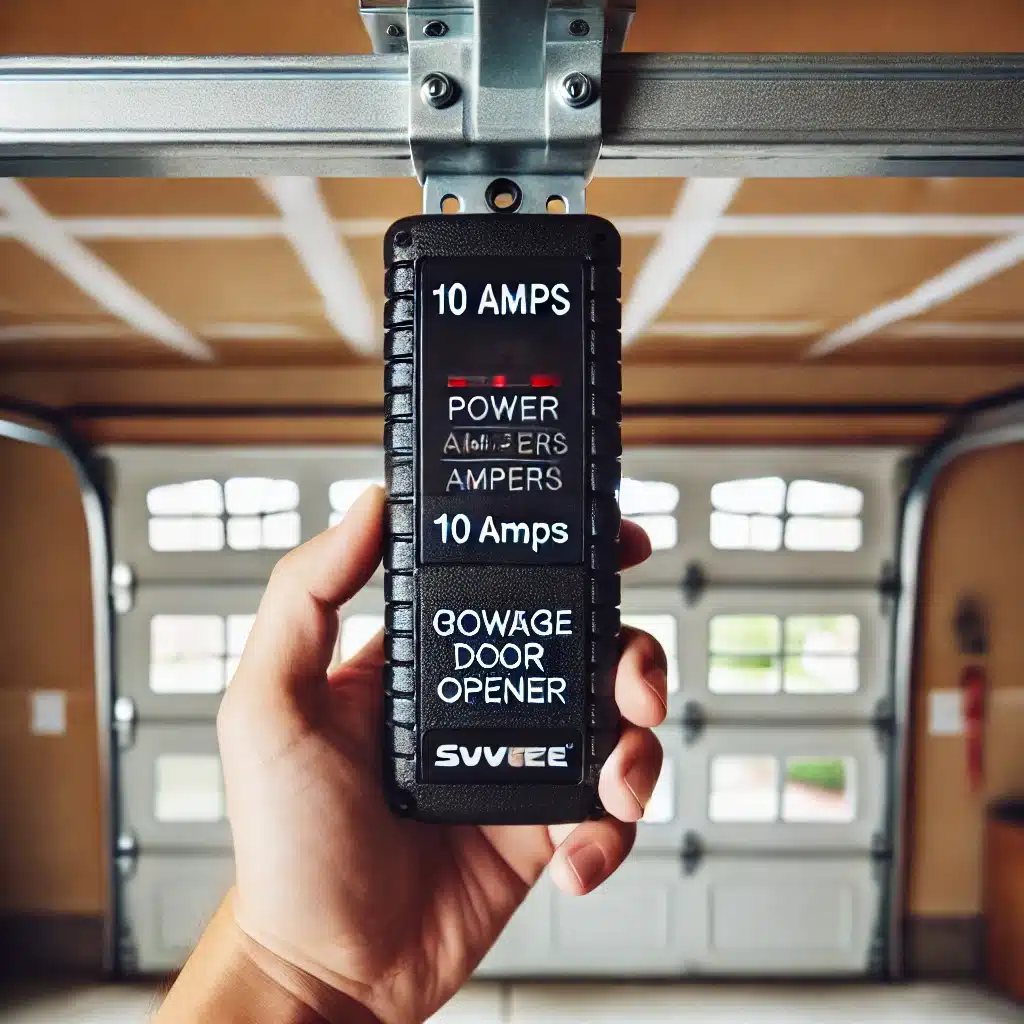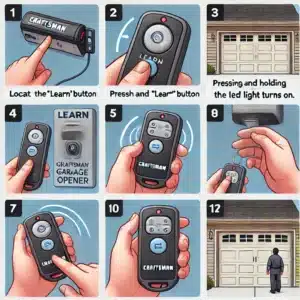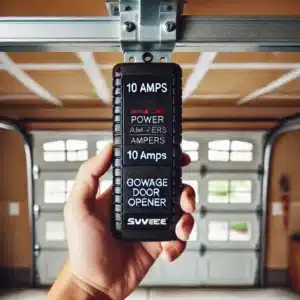When considering home improvements, it’s common to overlook the electrical demands of our devices. One question that often arises is, how many amps does a garage door opener use? Generally, a garage door opener uses around 5-7 amps, but this can vary based on the model and additional features. Understanding this can help ensure your garage door opener is running efficiently and safely without overloading your electrical system. Read on to discover more about what influences the amperage and how to choose the right garage door opener for your needs.

Understanding Amperage and Garage Door Openers
To dive into how many amps a garage door opener uses, it’s essential first to understand what amperage is. Amperage, often referred to simply as “amps,” measures the amount of electrical current flowing through a circuit. Think of it as the volume of electricity moving through your wires. The higher the amperage, the more electricity is flowing.
In electrical devices, including garage door openers, knowing the amperage is crucial for several reasons:
- Safety: Electrical systems in homes are designed to handle a specific amount of current. Exceeding this limit can overheat wires, trip circuit breakers, or even cause fires. Ensuring your garage door opener operates within safe amperage levels helps prevent these hazards.
- Efficiency: Devices that use the correct amount of amperage function more efficiently. If a garage door opener uses too much or too little power, it can wear out faster or not work properly.
- Compatibility: Home electrical circuits are typically rated for 15 or 20 amps. Knowing the amperage of your garage door opener ensures that it’s compatible with your existing wiring and won’t overload your circuits.
Basic Electrical Concepts Related to Garage Door Openers
To appreciate the importance of amperage, it’s helpful to grasp a few basic electrical concepts:
- Voltage (V): This is the pressure that pushes electrical current through a wire. Most garage door openers in North America operate on standard household voltage of 120V.
- Watts (W): This is the measure of electrical power. It’s calculated by multiplying voltage (V) by amperage (A). For example, a 120V garage door opener using 5 amps consumes 600 watts of power (120V x 5A = 600W).
- Circuit Breakers: These are safety devices in your electrical panel that protect circuits from overloading. If a circuit breaker trips, it’s a sign that something on the circuit is drawing too much current. Ensuring your garage door opener uses the appropriate amperage helps prevent these trips.
By understanding these basic concepts, you can better appreciate how your garage door opener fits into your home’s electrical system and why knowing its amperage is so important.
Factors Affecting the Amperage of a Garage Door Opener
When it comes to the amperage used by garage door openers, several factors can cause variations. Understanding these factors will help you choose the right opener for your needs and ensure your home’s electrical system can handle it.
Different Types of Garage Door Openers
Garage door openers come in several types, each with its own characteristics and amperage requirements:
- Chain-Drive Openers:
- Description: These openers use a metal chain to lift and lower the garage door.
- Amperage: Generally, chain-drive openers are more robust and require more power, typically at the higher end of the 5-7 amps range. They are known for their strength and durability, making them ideal for heavier doors. However, they can be noisier, which might not be suitable for garages close to living spaces.
- Description: These openers use a metal chain to lift and lower the garage door.
- Belt-Drive Openers:
- Description: These use a rubber belt instead of a chain, providing quieter operation.
- Amperage: Belt-drive openers usually consume slightly less power than chain-drive models, averaging around 5-6 amps. They are an excellent choice for attached garages where noise reduction is important.
- Description: These use a rubber belt instead of a chain, providing quieter operation.
- Screw-Drive Openers:
- Description: These utilize a threaded steel rod to move the door.
- Amperage: Screw-drive openers fall in between chain and belt drives in terms of power consumption, typically using about 6 amps. They are known for their reliability and low maintenance, though they can be noisier than belt-drive models.
- Description: These utilize a threaded steel rod to move the door.
How the Type of Drive Affects the Amperage
The type of drive mechanism in a garage door opener significantly impacts its amperage draw:
- Chain-Drive: Due to the mechanical resistance and the effort needed to move the chain, these openers tend to draw more current, especially when lifting heavier doors. The robust build often translates to a higher electrical demand.
- Belt-Drive: The smooth operation of a belt-drive requires less mechanical effort, thus typically drawing less amperage. The rubber belt reduces friction and mechanical resistance, making it more efficient in terms of power consumption.
- Screw-Drive: These openers balance the power needs of chain and belt drives. The direct drive system requires consistent but moderate power, resulting in a stable amperage draw that is sufficient for most residential doors.
Additional Features That May Increase Amperage
Modern garage door openers come with a variety of additional features that can impact their amperage usage:
- Integrated Lighting:
- Many openers come with built-in lights that turn on when the door is operated. These lights can add to the overall amperage draw, particularly if they are high-wattage bulbs.
- Many openers come with built-in lights that turn on when the door is operated. These lights can add to the overall amperage draw, particularly if they are high-wattage bulbs.
- Wi-Fi Connectivity:
- Smart garage door openers that connect to your home Wi-Fi network for remote operation and monitoring tend to use more power. The Wi-Fi module itself requires a continuous power supply, which can slightly increase the amperage.
- Smart garage door openers that connect to your home Wi-Fi network for remote operation and monitoring tend to use more power. The Wi-Fi module itself requires a continuous power supply, which can slightly increase the amperage.
- Battery Backup:
- Some garage door openers come with battery backup systems to ensure operation during a power outage. Charging and maintaining these batteries can increase the overall power consumption, thus raising the amperage.
- Some garage door openers come with battery backup systems to ensure operation during a power outage. Charging and maintaining these batteries can increase the overall power consumption, thus raising the amperage.
- Extra Security Features:
- Openers with advanced security features like motion sensors, additional locks, and cameras may also draw more power. These components need a continuous power supply to function, adding to the total amperage.
- Openers with advanced security features like motion sensors, additional locks, and cameras may also draw more power. These components need a continuous power supply to function, adding to the total amperage.
By understanding these factors, you can make an informed decision when selecting a garage door opener. It’s important to consider not just the base amperage of the opener, but also the additional power requirements of any extra features. This ensures that your opener will function efficiently without overloading your home’s electrical system.
Average Amperage Ratings for Common Models
When choosing a garage door opener, understanding the average amperage ratings for popular brands and models can guide you to make the best decision for your home. Here, we break down the amperage use for some of the most common garage door opener models and compare basic models with feature-rich options.
Breakdown of Amperage Use for Popular Garage Door Opener Brands and Models
- Chamberlain B550 Belt Drive Garage Door Opener:
- Amperage: Approximately 5 amps
- Features: This model is known for its quiet operation and reliability. It includes built-in Wi-Fi for smart home integration and MyQ technology, which allows you to control the opener from your smartphone.
- Amperage: Approximately 5 amps
- Liftmaster 8500 Wall Mount Garage Door Opener:
- Amperage: Around 6 amps
- Features: The LiftMaster 8500 is a space-saving wall-mounted model that offers battery backup and Wi-Fi connectivity. Its higher amperage is due to the added features and the DC motor.
- Amperage: Around 6 amps
- Genie ChainMax 1000 Chain Drive Garage Door Opener:
- Amperage: Approximately 7 amps
- Features: This robust chain-drive model is designed for heavy-duty performance. It includes a powerful motor and integrated lighting, which contributes to its higher amperage usage.
- Amperage: Approximately 7 amps
- Sommer Direct Drive 1042V001 Garage Door Opener:
- Amperage: Around 5 amps
- Features: Known for its quiet operation, the Sommer Direct Drive uses unique traveling motor technology. It has fewer moving parts, which helps maintain a lower amperage.
- Amperage: Around 5 amps
- Craftsman ½ HP Chain Drive Garage Door Opener:
- Amperage: Approximately 6 amps
- Features: This Craftsman model offers a good balance of power and affordability. It includes basic security features and integrated lighting, with moderate amperage use.
- Amperage: Approximately 6 amps

Comparison of Basic vs. Feature-Rich Models
When comparing basic garage door openers to feature-rich models, the difference in amperage use can be significant. Here’s how they stack up:
- Basic Models:
- Amperage Range: Typically 4-5 amps
- Features: Basic models usually include essential functions such as simple open/close mechanisms, basic security features, and standard motors. They are designed to be cost-effective and efficient, with minimal additional power requirements.
- Examples: Models like the Chamberlain C205 and the Genie ChainDrive 550 fall into this category. They provide reliable performance with straightforward features.
- Amperage Range: Typically 4-5 amps
- Feature-Rich Models:
- Amperage Range: Typically 6-8 amps
- Features: These models come equipped with a variety of advanced features such as Wi-Fi connectivity, battery backup, integrated cameras, advanced security systems, and smart home compatibility. The additional technology and components require more power, leading to higher amperage use.
- Examples: The LiftMaster WLED and Chamberlain B970 are prime examples of feature-rich models. They offer enhanced convenience and security but consume more power due to their extensive feature sets.
- Amperage Range: Typically 6-8 amps
In conclusion, while basic garage door openers are more energy-efficient with lower amperage ratings, feature-rich models provide additional convenience and security at the cost of higher power consumption. Knowing the amperage ratings and features of different models helps you choose an opener that fits your needs without overwhelming your home’s electrical system. Consider your requirements carefully, balancing features with power consumption, to ensure you select the best garage door opener for your home.
How to Measure Amperage of Your Garage Door Opener
Knowing the exact amperage draw of your garage door opener can be incredibly useful, especially if you’re troubleshooting electrical issues or planning upgrades. Here’s a step-by-step guide on how to measure the amperage using a clamp meter, along with essential safety precautions.
Step-by-Step Guide on Measuring the Amperage Using a Clamp Meter
- Gather Your Tools:
- You will need a clamp meter, which is specifically designed to measure current without directly contacting live wires. Ensure your clamp meter is rated for the expected amperage range of your garage door opener.
- You will need a clamp meter, which is specifically designed to measure current without directly contacting live wires. Ensure your clamp meter is rated for the expected amperage range of your garage door opener.
- Read the Manual:
- Before you start, read the user manual for both your garage door opener and the clamp meter. Familiarize yourself with the safety instructions and operational procedures.
- Before you start, read the user manual for both your garage door opener and the clamp meter. Familiarize yourself with the safety instructions and operational procedures.
- Turn Off the Power:
- For safety, turn off the power to the garage door opener at the circuit breaker. This will prevent any accidental electrical shock while you’re setting up.
- For safety, turn off the power to the garage door opener at the circuit breaker. This will prevent any accidental electrical shock while you’re setting up.
- Access the Electrical Wires:
- Open the cover of your garage door opener to access the electrical wires. Look for the wires that connect the opener to the power source. If necessary, consult the manual for your specific model to locate these wires.
- Open the cover of your garage door opener to access the electrical wires. Look for the wires that connect the opener to the power source. If necessary, consult the manual for your specific model to locate these wires.
- Prepare the Clamp Meter:
- Set your clamp meter to the appropriate setting for measuring AC current (usually marked with an “A” or “AC”). Open the jaws of the clamp meter.
- Set your clamp meter to the appropriate setting for measuring AC current (usually marked with an “A” or “AC”). Open the jaws of the clamp meter.
- Clamp Around the Live Wire:
- Carefully clamp the meter around one of the power wires. Do not clamp both wires at the same time, as this will cancel out the measurement. If you’re unsure which wire to clamp, consult the manual or a professional electrician.
- Carefully clamp the meter around one of the power wires. Do not clamp both wires at the same time, as this will cancel out the measurement. If you’re unsure which wire to clamp, consult the manual or a professional electrician.
- Turn On the Power:
- After securely clamping the meter around the wire, turn the power back on at the circuit breaker.
- After securely clamping the meter around the wire, turn the power back on at the circuit breaker.
- Operate the Garage Door Opener:
- Use the remote or wall switch to operate the garage door opener. The clamp meter will measure the current as the opener operates. Note the reading displayed on the meter.
- Use the remote or wall switch to operate the garage door opener. The clamp meter will measure the current as the opener operates. Note the reading displayed on the meter.
- Record the Amperage:
- Record the amperage reading for reference. You may want to take multiple readings to ensure accuracy, especially during different operational phases (starting, running, and stopping).
- Record the amperage reading for reference. You may want to take multiple readings to ensure accuracy, especially during different operational phases (starting, running, and stopping).
- Turn Off the Power and Remove the Clamp Meter:
- Once you have your readings, turn off the power at the circuit breaker again and carefully remove the clamp meter. Close the cover of the garage door opener.
- Once you have your readings, turn off the power at the circuit breaker again and carefully remove the clamp meter. Close the cover of the garage door opener.
Safety Precautions When Measuring Electrical Devices
- Wear Protective Gear:
- Always wear safety goggles and insulated gloves when working with electrical devices. This reduces the risk of injury from accidental electrical shocks or sparks.
- Always wear safety goggles and insulated gloves when working with electrical devices. This reduces the risk of injury from accidental electrical shocks or sparks.
- Work in Dry Conditions:
- Ensure your work area is dry. Water and electricity are a dangerous combination, increasing the risk of electrical shock.
- Ensure your work area is dry. Water and electricity are a dangerous combination, increasing the risk of electrical shock.
- Use the Right Tools:
- Only use tools and equipment rated for electrical work. A clamp meter should be in good condition and rated for the current you expect to measure.
- Only use tools and equipment rated for electrical work. A clamp meter should be in good condition and rated for the current you expect to measure.
- Never Touch Live Wires:
- Avoid direct contact with live electrical wires. Always handle wires with insulated tools and ensure the power is off before making any adjustments.
- Avoid direct contact with live electrical wires. Always handle wires with insulated tools and ensure the power is off before making any adjustments.
- Consult a Professional:
- If you’re not confident in your ability to safely measure electrical current, consult a licensed electrician. It’s better to be safe and ensure the job is done correctly.
- If you’re not confident in your ability to safely measure electrical current, consult a licensed electrician. It’s better to be safe and ensure the job is done correctly.
- Follow Manufacturer Instructions:
- Adhere to all instructions and warnings provided by the manufacturers of your garage door opener and clamp meter. These guidelines are designed to keep you safe and ensure accurate measurements.
- Adhere to all instructions and warnings provided by the manufacturers of your garage door opener and clamp meter. These guidelines are designed to keep you safe and ensure accurate measurements.
By following these steps and precautions, you can safely and accurately measure the amperage of your garage door opener. Understanding its electrical demands helps you maintain your system efficiently and ensures that it operates within the safe limits of your home’s electrical infrastructure.
Choosing the Right Garage Door Opener Based on Amperage
Selecting the right garage door opener involves considering the amperage to ensure safe and efficient operation within your home’s electrical system. Here are tips on choosing an opener with the appropriate amperage and considerations for energy efficiency and the electrical capacity of your garage.

Tips on Selecting a Garage Door Opener with Appropriate Amperage for Your Home
- Determine Your Garage’s Electrical Capacity: Understand your garage’s electrical capacity by checking the circuit breaker’s rating, usually 15 or 20 amps. Ensure the combined load of all devices on the circuit does not exceed this rating.
- Assess Your Door’s Weight and Size: Heavier doors need more powerful motors, which draw more amps. Ensure your chosen opener can handle the door’s weight without straining the motor.
- Compare Amperage Ratings of Different Models: Review the amperage ratings of various openers. Look for models that provide sufficient power without unnecessarily high amperage. Basic models draw less current, while feature-rich models may consume more.
- Consider Your Usage Pattern: If you frequently use your garage door opener, choose a model with a motor that can handle repeated use without overheating or excessive power consumption.
- Prioritize Reliable Brands: Choose openers from reputable brands like Chamberlain, LiftMaster, Genie, and Craftsman, known for reliability and accurate power ratings.
Considerations for Energy Efficiency and Electrical Capacity of Your Garage
- Energy-Efficient Models: Opt for energy-efficient openers with DC motors, which are generally more efficient than AC motors. Features like soft start and stop reduce electrical load during operation.
- Integrated LED Lighting: Modern openers with built-in LED lights consume less power than traditional incandescent bulbs, reducing overall amperage draw.
- Smart Features and Connectivity: Smart features like Wi-Fi connectivity can increase power consumption. Ensure your electrical system can handle the additional load. Choose energy-efficient models with minimal additional power requirements.
- Battery Backup Systems: Battery backup systems ensure operation during power outages but draw power to keep the battery charged. Consider the additional amperage draw of these systems.
- Future-Proofing Your Installation: Ensure your garage’s electrical system has capacity to spare for future needs. This is important if you plan to add other electrical devices or upgrade your opener in the future.
- Professional Installation and Consultation: Consult a professional electrician to assess your garage’s electrical capacity and ensure safe installation. Professional installation can prevent circuit overloads and ensure optimal performance.
By considering these factors, you can choose a new garage door opener that meets your functional requirements and operates efficiently and safely within your home’s electrical system. Selecting the right model with the appropriate amperage ensures long-term reliability and performance.
Frequently Asked Questions on How Many Amps Does a Garage Door Opener Use
Can a Garage Door Opener Trip a Circuit Breaker? Yes, a garage door opener can trip a circuit breaker if it exceeds the circuit’s amp rating. Circuit breakers prevent electrical overloads by cutting off power when the current surpasses safe levels, indicating the opener draws too much power for the circuit.
Does a Garage Door Opener Use More Amps When Starting? Yes, garage door openers draw more amps during startup due to the inrush current needed to overcome the door’s inertia. Once the door is moving, the amp draw stabilizes at a lower level, causing minimal light dimming during operation.
Are There Energy-Efficient Garage Door Openers? Yes, energy-efficient garage door openers use fewer amps and operate efficiently. Models with DC motors consume less power than AC counterparts, often featuring LED lighting and smart connectivity to reduce energy usage and utility costs.
How Does Age Affect Garage Door Opener Amperage? Older garage door openers typically use more amps due to wear, less efficient components, and outdated technology. Upgrading to newer models often reduces amp draw and improves performance.
Can I Use an Extension Cord? Using an extension cord with a garage door opener is generally not recommended. Extension cords can cause voltage drops, increase amp draw, strain the motor, and pose electrical hazards. A dedicated outlet installed by a professional electrician ensures safety and efficiency.
Conclusion
Understanding the amperage requirements of your garage door opener is crucial for safe and efficient operation. Throughout this guide, we’ve covered key aspects of amperage and garage door openers:
- Basics of amperage in electrical devices and its importance.
- Factors influencing garage door opener amperage, including drive type and features.
- Tips for measuring amperage and choosing the right opener.
- Safety precautions and energy efficiency considerations.
Knowing your opener’s amperage draw prevents overloading your electrical system and averting circuit trips, overheating, and hazards. Opt for a model with suitable amperage and energy-efficient features to ensure reliable, safe operation while minimizing energy use.
Safety is paramount with electrical devices, especially when dealing with garage door repair; consult a professional electrician for any uncertainties. Explore more detailed guides on home improvement and electrical safety for informed decisions on enhancing your home’s safety and efficiency.





